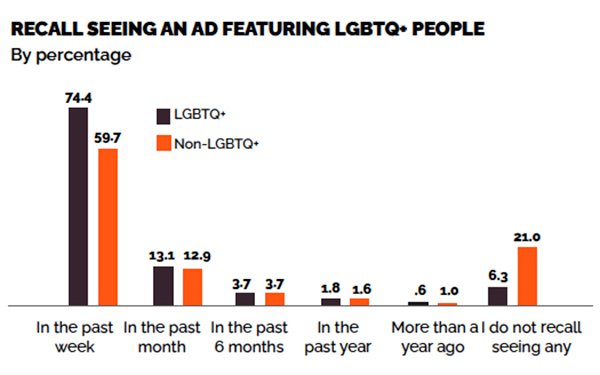
Data released this week suggests LGBTQ+ ad campaigns may
not be placed in media where non-LGBTQ+ and older people are likely to see them.
DISQO, a consumer insights platform, and Do The WeRQ, which works to increase LGBTQ+ representation
and share-of-voice in the advertising industry, released research on how Americans views LGBTQ+ representation in the marketing content they consume.
The survey of more than 10,000 people,
fielded during Pride month, between June 10 and June 21, shows nearly 29% of respondents said they did not recall seeing any LGBTQ+ advertising. More than 27% of respondents also said brands should
create less LGBTQ+ focused work.
Graham Nolan, co-chair of Do The WeRQ co-chair, storytelling and partnerships, believes the findings show a need to support LGBTQ+ ideas and representation in
advertising and the importance of having LGBTQ+ talent creating those ads.
Less than 13% of respondents aged between 18 and 24 said they did not recall seeing any ads, and less than 14% of
those 25-34 said the same.
About 19% of people between the ages of 35 and 44 said they did not recall seeing ads, and the percentage increased with each older group. For example, 20% between
45 and 54 said they did not see ads, 23% between 55 and 64, and nearly 29% 65 and older.
Of respondents who identified themselves as LGBTQ+, only 6.34% said they did not recall seeing any
LGBTQ+ ads, whereas 21% of those who said they were not LGBTQ+ said they did not recall seeing any such ads.
Is there lack of support for advertising and media professionals?
Only 43.6% of respondents said it was important to them advertising and content are made with the involvement of people who are part of specific communities. Some 70.55% of respondents who
self-identified as LGBTQ+ said it was important to them, in contrast to the 40.7% of non-LGBTQ+ identifying respondents who said the same.
Nearly 52% of non-LGBTQ+ respondents
believe LGBTQ+ people working in advertising can make good contributions to non-LGBTQ+ content. Whereas 75.6% of LGBTQ+ individuals believe LGBTQ+ workers can make good contributions to non-LGBTQ+
content.
Regardless of LGBTQ+ identity, 33.36% of respondents believe most advertising representing specific communities is made by people in that community.
Members of ethnic
minorities are generally likely to want more LGBTQ+ advertising. Asian Americans, 26.6%, and African Americans, 21.4%, were enthusiastic. Caucasian, Native Americans and Pacific Islanders were less
likely than other minorities to support an increase. Caucasian were the most likely to say they wanted less LGBTQ+ content, 30.2%, with African Americans at 20.57% and Asian Americans, at 15.38%, the
least likely.